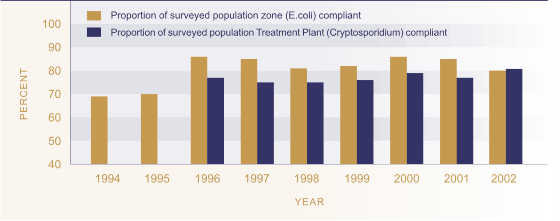Relevance
Maintaining good drinking water quality is critical for human health and quality of life outcomes. The health risk to consumers from water-borne disease in drinking water supplies comes from two main types of microbiological organisms: bacteria (such as faecal coliforms, and E. coli), and parasites (such as Giardia, and Cryptosporidium). Improvements in this indicator ensure that less of the population is at risk of water-borne disease and other contaminants.
Current Level And Trends
The majority of New Zealanders are supplied with community drinking water that is free of micro-organisms. The proportion of New Zealanders whose drinking water, measured at the tap, complies with the 1995 drinking water standards regarding E. coli increased from 69 percent in 1994 to 80 percent in 2002. Overall the level of E. coli compliance has fluctuated over the second half of the 1990s from between 80 and 86 percent. Most water supplies serving large population areas are fully compliant with the 1995 standards. The main reason for non-compliance is inadequate monitoring rather than the actual contamination of drinking water. Inadequate monitoring is the reason behind the slight decrease in E. coli compliance between 2001 and 2002.
Compliance with the 1995 drinking water standards for Cryptosporidium is measured at the water treatment plant rather than at the tap. Data is not available for Cryptosporidium compliance before 1996. Since 1996, the compliance rate has increased slightly from a value of 77 percent in 1996 to 81 percent in 2002. Between these years there was some measured fluctuation in levels of compliance with a low of 75 percent in 1997 and 1998.
While the proportion of consumers with fully compliant drinking water supplies has remained fairly flat since 1996, this reflects the replacement of the 1984 standards with the more stringent standards adopted in 1996 rather than any decline in water treatment over this time.
Figure EN2.1 Proportion of the surveyed
population served with water that meets drinking water standards,
1994-2002

Source: Ministry of Health (2002b)
Regional Differences
Groundwater sources supply drinking water for about 40 percent of the New Zealand population, while about 60 percent of people are supplied from surface (catchment) water. Most water in catchment headwaters is of good quality, but problems with the quality of some groundwater sources have been identified.
There is considerable regional variation in the population served with drinking water that is fully compliant. In 2002, only 13 percent of the population in Otago and 21 percent of the population in Southland were served with drinking water that fully complied with the 1995 drinking water standards. Waikato and Northland also had particularly low compliance rates, varying between 32 percent and 38 percent of the population covered. Compliance in Auckland, Tauranga and Wellington, however, was close to 100 percent. The vast majority of non-compliance is due to inadequate monitoring, rather than actual contamination. This is the main reason for low levels of compliance in Northland, Waikato and Otago in 2002.
Where drinking water quality is affected, the agricultural sector is seen as the most important source of water quality problems.75
International Comparison
Overall, the quality of New Zealand water is high by international standards. New Zealand's water supplies are free of many of the diseases that result in sickness and death in other countries. However, the incidence of infection from Giardia in water supplies is 85 per 100,000 people, which is considered high compared to the reported rates for other western countries.76
